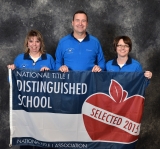-
Category 1
Selected in 2015
-
Grades: pre k - 6
School Setting: rural
Town Population: 485
Student Enrollment: 121
Student Demographics:
Black/African American: 2%
Teacher/Student Ratio: 1:13
White/Caucasian: 96%
Hispanic: 0%
Hawaiian/Pacific Islander: 0%
Asian: 0%
Native American: 2%
Other: 0%
% Reduced Lunch: 56%
% ELL Learners: 0%
Founded: 1880 -
PRINCIPAL:
Steven Chaney -
CONTACT:
#1 Bluebird Lane
Mount Pleasant, AR 72556
870-346-5194
steven.chaney@melbourneschools.org
Mount Pleasant Elementary School
Mount Pleasant, AR
Mount Pleasant Elementary’s success can be attributed to the teachers and staff sharing a common bond with the parents and community. The goal is to make this school the best possible learning environment for the children and for it to be a an integral part of the community.
- Describe specific programs in place to ensure that families are involved in the success of your school and students.
-
Parents, students and patrons of the community and school district have access to the school performance data through a variety of sources. Combined population student achievement results are communicated through the use of three local newspapers and radio station. School report cards are mailed to the parents by the Arkansas Department of Education. Access to the school report cards may also be found at http://normes.uark.edu. An annual report to the public that summarizes and compares the assessment data for the school, district, and state is published in October each year. The report to the public, along with testing results, is presented at required public school building and district meetings in the fall.
After the testing results arrive in the summer, individual student results are mailed to the parents/guardians along with an explanation to guide parents in reading the results. During the first week of school in the fall, parents, students, and community are invited to the school for open house, which begins with a public meeting in the cafeteria to introduce teachers and staff and to give an overview of what to expect in the coming year. The principal and teachers give a presentation that includes the following: State assessments; Common Core State Standards; adequate yearly progress; annual measureable objective; along with how our school measures in comparison to last year’s performance, the district, and the state. Parents are given the opportunity to view and discuss the child's performance results with the teacher. If necessary, the teacher, parent, and student make an appointment to examine and develop an academic improvement plan for the student not scoring proficient or advanced. Parents who are unable to attend are contacted by the classroom teacher.
The school has two scheduled parent/teacher conferences. During those meetings, the teacher discusses strengths and weaknesses the child may encounter during the assessment. Strategies to help the child succeed are discussed. Phone conferences are conducted when the parents cannot attend the scheduled meetings.
Once spring testing is completed, the teachers, staff, and parents reward the students with a community-wide cookout. Everyone is invited to have hamburgers and hotdogs and to enjoy a night of activities, such as bouncy houses, basketball, baseball, and other games.
- Describe the most successful activity your school has initiated to strengthen ties to your community.
-
- What is the single most important factor in the success of your school that others could replicate?
- Mount Pleasant Elementary’s success can be attributed to the teachers and staff sharing a common bond with the parents and community. The goal is to make this school the best possible learning environment for the children and for it to be a an integral part of the community. The Mount Pleasant community and school have always worked closely to instill in the students a sense of pride in who they are and what is necessary for them to become productive citizens in the United States. Traditions unique to this area have been developed and culminated by the community and school. Our parents and community are our strength.
- Identify the critical professional development activities you use to improve teaching and student learning.
-
Mt. Pleasant Elementary teachers and their administrator participate in professional development that assists in improving instructional methods. We, like our students, learn best practices through modeled instruction by highly qualified educators in all subject areas. Just as we set high expectations for our students, we must also set high expectations for our teaching. The faculty and staff look for staff development that assists them as they teach the required standards. The professional development should also be practical and useful for our students.
Based on the results of the State Assessments received in the summer, teachers analyze their own strengths and weaknesses in their individual classrooms. They are encouraged to attend staff development during the school year, but the majority of the professional development is completed in the summer months. Each teacher and paraprofessional discusses his/her individual professional growth plan with the principal. Strengths and weaknesses are identified, and they cooperatively develop a plan of action. Each teacher completes a survey indicating the instructional needs we should develop as individuals and as a school to help our students reach proficient or advanced and prepare them for their life beyond elementary school.
Since the school has transitioned into Common Core and the PARCC Assessments, teacher and administrators have attended professional development pertaining to requirements for each grade level, K-6. Another area of concern for teachers was the new teacher evaluation system that went into effect during the last two years. Teachers were required to receive at least 24 hours training in the summer of 2013. In 2014, they were required to get additional training, plus learn the new Bloomboard system.
- Describe how data is used to improve student achievement and inform decision making.
-
. Through analysis of the summative and formative assessment data obtained from the State Mandated Testing, teachers and administrators at Mt. Pleasant Elementary School determine instructional goals and strategies necessary to continue making adequate yearly progress. The teachers, paraprofessionals, and principal meet one week in the summer for staff development to examine the student data. As we disaggregate the data received from the test results, we determine the strengths and weaknesses of classroom instruction in math and literacy.
The data analysis process begins by looking at the results of the combined population school summary report for math and literacy from the spring testing. The next step is to make a chart of the school summary report and the school roster information reflecting the three-year data. This information includes: the average percentage of students meeting standards; comparison of multiple-choice and open response percentages in math, reading, and writing. Comparisons are made to determine strengths and weaknesses in instruction of the math strands, reading strands, and writing domains for the current year and the three-year averages. Once this information is found, teachers analyze the item-by-item results for each class by determining the student learner expectation that was tested for those combined scores that fell below the 60th percentile. This process of analysis is then repeated for the Students with Disabilities.
Teachers and paraprofessionals work in small groups as they analyze and discuss the testing results. Areas of concern, instructional strategies needed to improve, reviewing of curriculum mapping, and listings of students in need of an academic improvement plan are all determined. Based on the strengths and weaknesses found in the strands of student learner expectations, teachers can then make modifications in their horizontal and vertical mapping, plan instructional strategies, as well as formulate goals for the Mt. Pleasant Elementary School Improvement Plan. Plans of action are discussed and developed.
As the school year progresses, a variety of assessment strategies are used to determine the progress all students are making, with emphasis on those students working on an academic improvement plan. Assessments include teacher-made evaluations and observations, textbook evaluations, target testing for math and literacy, DIBELS, DRA testing, STAR Reading and Math, Headsprout and ORCHARD. Gains or losses made by students are communicated throughout the year in the staff meetings, as well as frequent reports to parents or guardians. Those students requiring remediation are offered before and after school tutoring, in-school enrichment classes, assistance from a foster grandparent, peer tutoring, and small group work in the regular classroom.
The assessment results are mailed to the parents along with a letter of explanation on what the results mean. Students who do not meet standards will be placed on an academic improvement plan. The parent, student, and teacher collaborate as they determine actions that best complete the intervention plan to insure the child reaches proficiency. Students receive immediate feedback from the teacher. Parents receive daily or weekly progress reports on the child through notes being sent home or by visiting the district website on EDLINE. The community is informed of the testing results when the annual report to the public is made at the Mount Pleasant Elementary Open House the week school begins. Also, an article reflecting the annual report of the test results for each school in the district, will be published in the local newspapers.
- Describe your school culture and explain changes you’ve taken to improve it.
-
Mount Pleasant Elementary teachers, staff, and parents strive to educate all students to achieve their highest academic potential. It is the philosophy of the educators to set higher expectations for our students as we challenge each of them with a rigorous curriculum coordinated with planned extracurricular activities to help each one to achieve maximum personal development in all areas. Our traditional curriculum, partnered with technology, promotes higher-order thinking skills and has been aligned with the Common Core Standards.
Activities scheduled throughout the school year motivate and ensure students maintain their educational focus. Some of these special events include: Dr. Seuss Week, Accelerated Reader Field Trips, Wildlife Guy, guest authors, and awards presentations. These events offer a break from the classroom routines and offer students incentives to keep focused on the importance of academics. Parent, student, teacher, and staff participation builds relationships between the school and home and conveys the importance of education.
The principal is well acquainted with each of the teachers, staff members, parents, and students. She is familiar with their programs, activities, and goals, and strives to help and support where needed to provide an educational environment that ensures all stakeholders feel safe and valued. The principal continually monitors the school’s social, physical, and behavioral environments, as well as student and staff expectations and supports in establishing and sustaining school norms that foster a positive culture and climate in which all students can thrive.
Students are encouraged by the teachers and the staff to not only make adequate yearly progress but to go beyond those standards and reach greater expectations. They learn at an early age that they are a very integral part of the Mount Pleasant Elementary and that they, their parents, the community and the school employees work together to help them achieve the goal of being exemplary. Most importantly, they are taught to respect and care for each other on a day to day basis and by contributing their time for events such as: annual Senior Citizen’s Christmas Dinner, all school reunion, community-wide cookout, and annual food drive for those in need.
As teachers, parents, administration, students, and community work together to make our school successful, a common bond is formed that creates a family-like environment where all individuals involved feel valued and supported.
Stats
-
Category 1
Selected in 2015
-
Grades: pre k - 6
School Setting: rural
Town Population: 485
Student Enrollment: 121
Student Demographics:
Black/African American: 2%
Teacher/Student Ratio: 1:13
White/Caucasian: 96%
Hispanic: 0%
Hawaiian/Pacific Islander: 0%
Asian: 0%
Native American: 2%
Other: 0%
% Reduced Lunch: 56%
% ELL Learners: 0%
Founded: 1880 -
PRINCIPAL:
Steven Chaney -
CONTACT:
#1 Bluebird Lane
Mount Pleasant, AR 72556
870-346-5194
steven.chaney@melbourneschools.org







